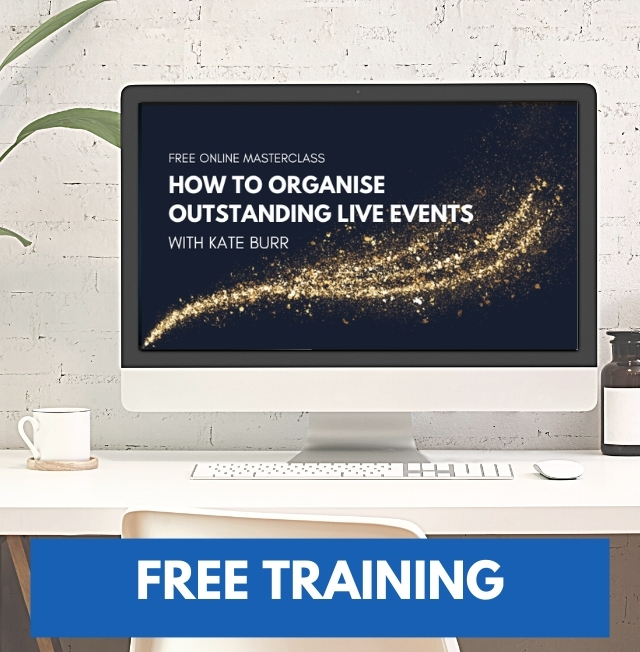I was recently chatting with a client, and we were talking about public speaking. He said, “Kate when it comes to public speaking, I’d put people into 3 categories:
- Really good at it,
- Happy to give it a go and
- Vomit!” [when they think about Public Speaking]
I wholeheartedly agreed (and maybe even snorted coffee out of my nose), but based on Jerry Seinfeld’s observations, I reckon my client is definitely right. Jerry Seinfeld said, “According to most studies, people’s number one fear is public speaking. Number two is death… This means to the average person, if you go to a funeral, you’re better off in the casket than doing the eulogy.”
Sad, but most probably true!
I think one of the reasons public speaking is feared by so many is because it makes people nervous. It rips people right out of their comfort zone and into the spotlight, where if they fail, they do so in front of a live audience. Ouch!
No wonder people get nervous!
Over the past 15 years, I’ve spoken on stage multiple times as an MC, Speaker and Stand Up Comedian. During that time I’ve picked up some useful tips that have got me to the point where I now actually enjoy speaking in public! Yes, it is possible!
It hasn’t always been like that of course, so here are the top 5 things that have helped me overcome my nerves when speaking or doing presentations in public.
Top 5 Ways to Overcome Nerves
1. Manage Your State
When you are nervous – your body goes into a fight or flight state. All the blood in your body rushes to your muscles as your body fills with adrenaline so you can run or fight.
Adrenaline sharpens your senses, which is excellent if you are trying to dodge a car or avoid a bear attack, but if you are speaking in front of an audience, it just means you experience everything more intensely, which actually makes it even more terrifying! Very helpful!
After that initial burst of adrenaline, if your body is still under stress, (which of course it would be – you still have to do that presentation don’t you!?!) a whole host of other hormones including cortisol kick in to respond to the stress and physically get you “the hell out of there”. (Source: University of Maryland Medical Centre). While your body is preparing to run or fight, it switches off all other unnecessary bodily functions like your brain’s ability to think and concentrate. Super helpful if you are trying to speak clearly and remember what to say next!
Solution: Rather than stumbling over your words and feeling like an idiot, physically try to counteract the fight or flight response. Move or shake your body to break down the adrenaline in your muscles. Then take long deep breaths, focus on returning the blood to your brain so you can remember what to say. Trick your body into thinking it’s calm. If you were in real danger, would you be sitting there sucking in the air? Of course not. Remind yourself – you don’t need to run – you need to calm the F*ck down!
2. Change Your Focus
So many people worry about themselves and how they’ll go speaking in public. Will they look stupid, will they remember what to say, will they have something stuck in their teeth. Guess what – it’s not about you! There’s a fair chance you are giving a speech or presentation to educate, inform, enlighten or entertain the audience, not to show off your speaking skills.
Solution: Change your focus from “will I do okay?” to “how can I best help the audience?” Stop worrying about yourself and instead focus on how can you add value? How can you make your presentation a worthwhile experience for your audience?
3. Set Yourself Up For Success
The room set up will have a significant impact on your success. I find that close, intimate rooms are best. The last thing you want is a big cavernous room with a few people dotted in amongst empty chairs or tables that are set up too far apart with big spaces between each table. There is no energy in these rooms, and it’s tough to get a good atmosphere that encourages interaction and engagement with an audience.
Also be aware of any barriers between you and the audience. Standing behind a lectern or a table can impact the connection you’ll have with an audience.
Solution: Set the room up so that the audience is comfortable and seated close to each other. Try to avoid empty space between tables or empty seats. Asking the MC to move the audience closer together before you speak, or placing a reserved sign on the back rows will ensure that the front seats fill up first and give a much better atmosphere, setting you up for success before you even start speaking.
4. Make The Audience Comfortable
When the audience is comfortable, it is much easier for them to listen to your message. An uncomfortable audience leads to audience fatigue. This may cause your audience to lose interest, disengage, get bored more quickly and struggle to take in the information being presented.
Trust me, you do not want to be looking out at the bored faces of a disengaged audience. It will not help you at all with your nerves!
Solution: Make the room as comfortable as possible with good seating, room temperature and set up so that everyone has a good clear view of the speaker. Ensure that you can be easily heard and use a microphone if needed. Eliminate or reduce background noises and other distractions.
5. Make the Audience Feel Good
We all like to enjoy ourselves and feel good, and your audience is no different. The easiest way to get your audience to feel good is by adding some humour and getting a few laughs. Laughter has been scientifically proven to reduce stress hormones and increase endorphins.
Therefore, if you do nothing else with your presentation than at least get a laugh or two, you will have provided substantial physiological and psychological benefits to your audience. Not to mention you’ll be looking at a room full of smiling people!
Think about how much nicer it will be to your presentation with smiling, friendly faces in the audience.
Solution: Make sure you add humour to your presentation. If you are not sure how to do this or want some tips on how to add humour to your presentation, I’m running a free online Masterclass called “How to Be Funny On Purpose”. Click on the link to register, and if you can’t attend at the time, register anyway, and I’ll send you a link of the replay. CLICK HERE to register.




